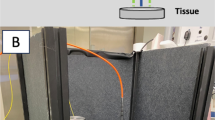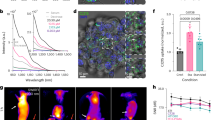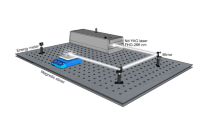Abstract
Laser-induced fluorescence (LIF) was used to characterise the localisation of an intravenously administered trimethylated carotenoporphyrin [CP(Me)3] and a trimethoxylated carotenoporphyrin [CP(OMe)3] in an intramuscularly transplanted malignant tumour (MS-2 fibrosarcoma) and healthy muscle in female Balb/c mice, 3, 24, 48 and 96 h post injection. The fluorescence was induced with a dye laser pumped by a nitrogen laser, emitting light at 425 nm. The fluorescence spectra were recorded in the region 455-760 nm using a polychromator equipped with an image-intensified CCD camera. The tumour/peritumoral muscle ratio was about 5:1 for CP(Me)3 and about 6:1 for CP(OMe)3 in terms of the background-free fluorescence intensity, which peaked at about 655 nm. By including the endogenous tissue fluorescence, the contrast was further enhanced by a factor of approximately 2.
Similar content being viewed by others
Article PDF
Author information
Authors and Affiliations
Rights and permissions
About this article
Cite this article
Nilsson, H., Johansson, J., Svanberg, K. et al. Laser-induced fluorescence in malignant and normal tissue in mice injected with two different carotenoporphyrins. Br J Cancer 70, 873–879 (1994). https://doi.org/10.1038/bjc.1994.413
Issue date:
DOI: https://doi.org/10.1038/bjc.1994.413
This article is cited by
-
Types of spectroscopy and microscopy techniques for cancer diagnosis: a review
Lasers in Medical Science (2022)
-
Laser-induced fluorescence: Progress and prospective for in vivo cancer diagnosis
Chinese Science Bulletin (2013)
-
Influence of tumour depth, blood absorption and autofluorescence on measurements of exogenous fluorophores in tissue
Lasers in Medical Science (1998)



